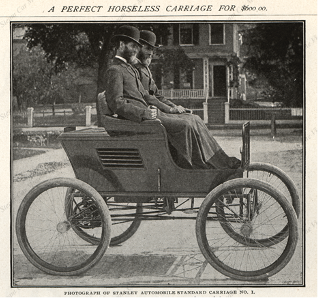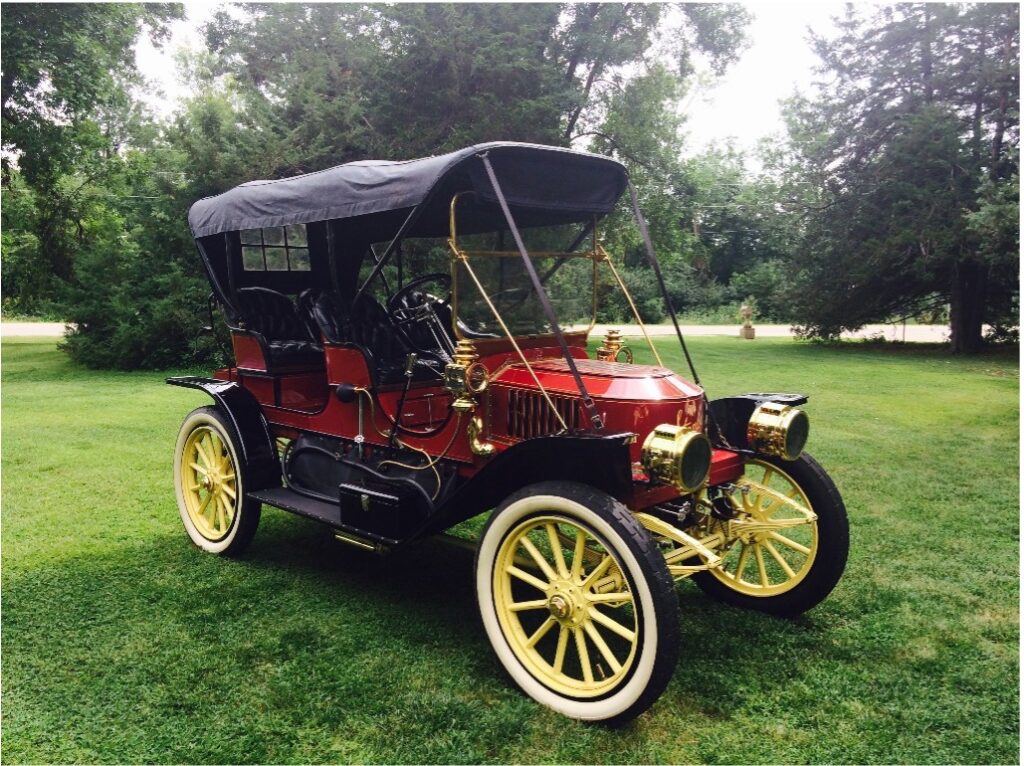The Antiques Class Goes Full Steam Ahead
May 2, 2024
The Antiques Class encompasses vehicles manufactured from the 1800s through 1927 when the last Ford Model T was produced. During those pioneering years, thousands of blacksmiths, buggy-makers, and backyard builders joined forces with manufacturing moguls. All shared one common goal – to replace 4-hooved horses with 4-wheeled horsepower. Each of these pioneers was eager to be first-to-market with a reliable product that performed well and would be capable of growing a successful business. Three emerging technologies were employed in relatively equal numbers: internal combustion, electricity, and steam.
Henry Ford’s spindly 1896 Quadricycle was not America’s first gasoline-powered horseless carriage, but it might be the best known. Ford used a single-cylinder internal combustion engine to putter his buggy around Dearborn. Millions of buyers followed in subsequent years. As Ford’s fame and fortune grew, he befriended Thomas Edison, inventor of the light bulb and a driving promoter of quiet and comfortable electric cars. Both options had pros and cons. Twin inventors Freelan and Francis Stanley said they had a better idea. They opted for steam.

In 1897, the Stanley brothers completed their first steam-powered automobile in Lawrence, Massachusetts. During the next two years, they produced more than 200 cars — more than any other U.S. manufacturer. In 1903, they sold a series of patents to George Eastman for a half-million dollars and used the money to relocate production to a former bicycle factory in nearby Watertown.
Stanley cars were rated at 10, 20, or 30 horsepower. However, steam cars were rated by boiler hp, not engine shaft hp. So, a typical 20HP Stanley’s engine had an output more than 100 peak horsepower. (By comparison, a 1910 Pierce-Arrow 48 with its massive 525 CI T-head engine developed just 48HP.) In 1906, Fred Marriott set the world record for the fastest mile in an automobile (127 mph) behind the wheel of a specially prepared Stanley dubbed “Woggle-Bug”. This record stood for five years.
Starting a cold Stanley 2-cylinder compound steam engine is labor intensive. It can take as long as 30 minutes to build up a sufficient head of steam in the 550 PSI boiler. Owners often kept the pilot lit overnight so their cars would be ready to go in the morning. A hot Stanley produces peak torque at standstill and takes off quickly and quietly with smooth acceleration. Since there is no transmission, shifting is not required.
Steam power had been used in ships and locomotives for decades where they earned a reputation for exploding under severe pressure. Fears of property damage and loss of life steered many wary automobilists toward gasoline and electricity. That was unfortunate, since there have been no documented cases of a Stanley boiler exploding in use, thanks to quality construction and a pressure relief valve. Burns, on the other hand (as Jay Leno can attest to), did occur.
Initially, all Stanleys were non-condensing, meaning the steam that passed through the engine was exhausted out. Beginning in 1915, condensers were added to reuse the vapors and improve driving range. The need to travel farther was necessitated, in part, by the shrinking availability of horse troughs as the country rapidly turned away from horses. Cruising range on level roads was roughly 1 MPG of water for non-condensing models, and 2 MPG on condensing cars.
By 1914, sales of gasoline-powered automobiles outpaced the alternatives. The Stanley brothers sold their business in 1917 and the factory closed in 1924. After more than 25 years of production, approximately 11,000 Stanleys had rolled off the assembly line. Today, more Stanleys are preserved, restored, and operating than any other brand of steam car.
Lynn Curry owns the red 1909 Stanley Model R Touring pictured here. Restored by Stanley specialist Jim Keith in 1996, this car has completed countless tours, including a 5,300 mile, 44-day trek from Anchorage, Alaska to Bar Harbor, Maine. With its red wooden body, polished brass, and steam exhaust, it is a dramatic example of vintage motoring. This is his second Stanley, the first being a 1910 Model 72 Roadster.

As owners of antique cars age, their treasures are often tucked away in garages and barns where they gather dust and deteriorate. Not so with Lynn. He is an active member of the Steam Automobile Club of America, has served as President of the Stanley Museum in Kingfield, Maine, and is a former Chair of the Des Moines Concours Antiques Class. Plus, he has passed his passion for steam cars down to sons Mike and Robert, and grandson Ethan. As a team, the Currys completed a tour of New England last year and will participate in the Eastern Steam Car Tour in Kentucky this coming June.
Be it gas, electric, or steam powered, the Des Moines Concours is always looking for owners of well-preserved and authentically restored antique automobiles to share their beloved piece of history. Apply to exhibit online HERE.



























